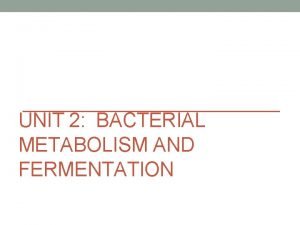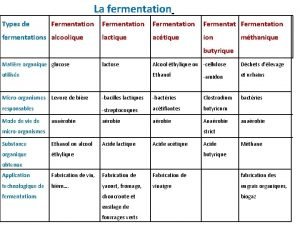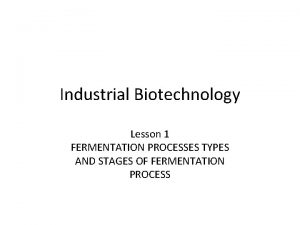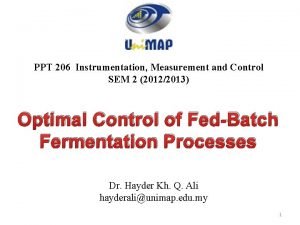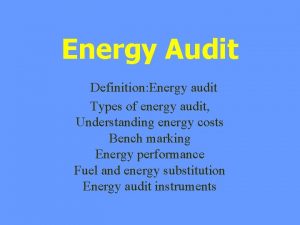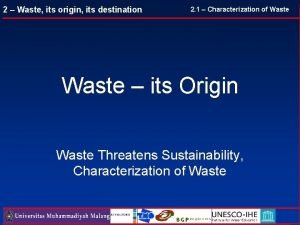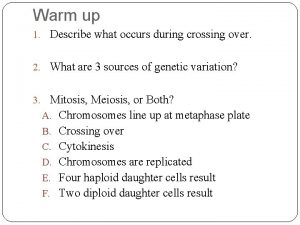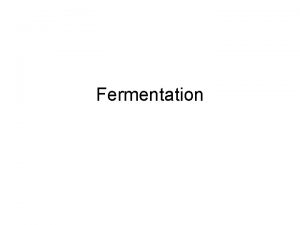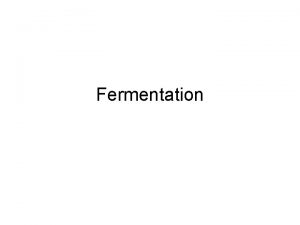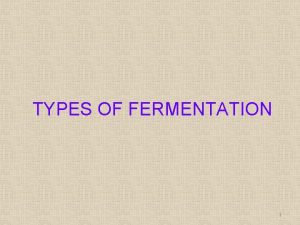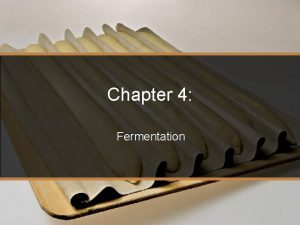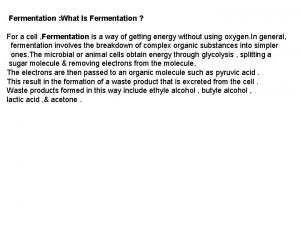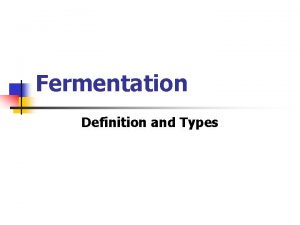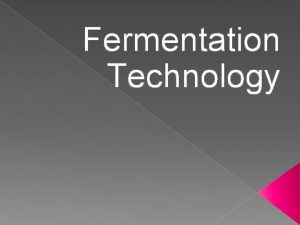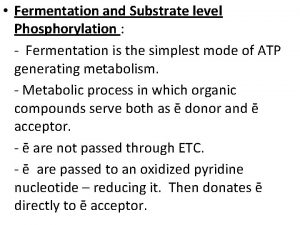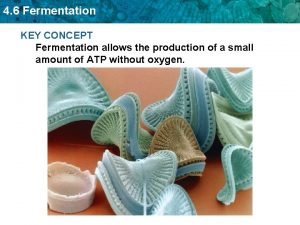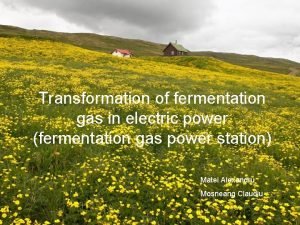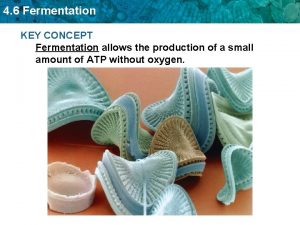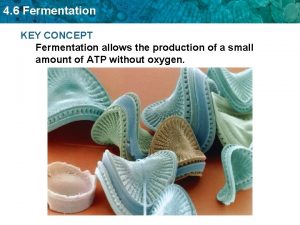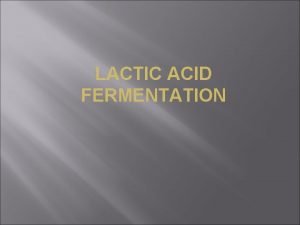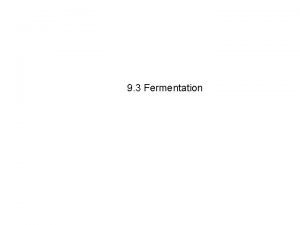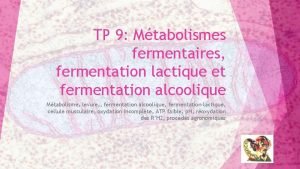FERMENTATION AND ITS TYPES INTRODUTION TO FERMENTATION Fermentation




























- Slides: 28

FERMENTATION AND ITS TYPES

INTRODUTION TO FERMENTATION Fermentation is a metabolic process that converts sugar to acids, gases or alcohol. It occurs in yeast and bacteria, and also in oxygen-starved ( Deficient ) muscle cells, as in the case of lactic acid fermentation. Fermentation, chemical process by which molecules such as glucose are broken down anaerobically.

Definition: • Fermentation is the chemical transformation of organic substances into simpler compounds by the action of enzymes, complex organic catalysts, which are produced by microorganisms such as molds, yeasts, or bacteria. • Enzymes act by hydrolysis, a process of breaking down or predigesting complex organic molecules to form smaller (and in the case of foods, more easily digestible) compounds and nutrients.


HISTORY OF FERMENTATION Fermentation is a natural process. People applied fermentation to make products such as wine, mead (Made of Fermented honey and water biochemical process ), cheese and beer long before the was understood. In the 1850 s and 1860 s Louis Pasteur became the first zymurgist (One who or scientist to study fermentation) when he demonstrated fermentation was caused by living cells.

TYPES BASED ON RESPIRATION Aerobic Fermentation: Aerobic fermentation means that oxygen is present. Wine, beer and acetic acid vinegar (such as apple cider vinegar), need oxygen in the “primary” or first stage of fermentation. When creating acetic vinegar, for example, exposing the surface of the vinegar to as much oxygen as possible, creates a healthy, flavorful vinegar with the correct p. H.

Aerobic Fermentation

Anaerobic Fermentation: • Anaerobic fermentation is a method cells use to extract energy from carbohydrates when oxygen or other electron acceptors are not available in the surrounding environment. • This differentiates it from anaerobic respiration, which doesn’t use oxygen but does use electron-accepting molecules that come from outside of the cell. • The process can follow glycolysis as the next step in the breakdown of glucose and other sugars to produce molecules of adenosine triphosphate (ATP) that create an energy source for the cell.

Through this method, a cell is able to regenerate nicotinamide adenine dinucleotide (NAD+) from the reduced form of nicotinamide adenine dinucleotide (NADH), a molecule necessary to continue glycolysis. • Anaerobic fermentation relies on enzymes to add a phosphate group to an individual adenosine diphosphate (ADP) molecule to produce ATP, which means it is a form of substrate-level phosphorylation.

• There are two major types of anaerobic fermentation: ethanol fermentation and lactic acid fermentation. Both restore NAD+ to allow a cell to continue generating ATP through glycolysis. Ethanol fermentation: • Ethanol fermentation converts two pyruvate molecules, the products of glycolysis, to two molecules of ethanol and two molecules of carbon dioxide. The reaction is a two-step process in which pyruvate is converted to acetaldehyde and carbon dioxide first, by the enzyme pyruvate decarboxylase.

• Yeast and certain bacteria perform ethanol fermentation where pyruvate (from glucose metabolism) is broken into ethanol and carbon dioxide. The net chemical equation for the production of ethanol from glucose is: C 6 H 12 O 6 (glucose) → 2 C 2 H 5 OH (ethanol) + 2 CO 2 (carbon dioxide) Ethanol fermentation is used the production of beer, wine and bread. It's worth noting that fermentation in the presence of high levels of pectin result in the production of small amounts of methanol, which is toxic when consumed.

Anaerobic fermentation -1

Lactic acid fermentation: • Lactic acid fermentation is a biological process by which glucose and other six-carbon sugars (also, disaccharides of six-carbon sugars, e. g. sucrose or lactose) are converted into cellular energy and the metabolite lactate. The pyruvate molecules from glucose metabolism (glycolysis) may be fermented into lactic acid. Lactic acid fermentation is used to convert lactose into lactic acid in yogurt production. It also occurs in animal muscles

When the tissue requires energy at a faster rate than oxygen can be supplied. The next equation for lactic acid production from glucose is: C 6 H 12 O 6 (glucose) → 2 CH 3 CHOHCOOH (lactic acid) The production of lactic acid from lactose and water may be summarized as: C 12 H 22 O 11 (lactose) + H 2 O (water) → 4 CH 3 CHOHCOOH (lactic acid) Yogurt is made by fermenting milk. It's high in protein, calcium, and probiotics ("good" bacteria).

TYPES OF FERMENTATION Homo Lactic fermentation: The fermentation in which only the lactic acid is produced. There is no any side product formed after the reaction. Hetero-Lactic Fermentation: The Fermentation in which the lactic acid is produced along with some by products like gases.

Anaerobic fermentation -2

MECHANISM OF FERMENTATION Fermentation takes place when the electron transport chain is unusable (often due to lack of a final electron receptor, such as oxygen), and becomes the cell’s primary means of ATP (energy) production. It turns NADH and pyruvate produced in glycolysis into NAD+ and an organic molecule (which varies depending on the type of fermentation). In the presence of O 2, NADH and pyruvate are used to generate ATP in respiration. This is called oxidative phosphorylation, and it generates much more ATP than glycolysis alone.

For that reason, cells generally benefit from avoiding fermentation when oxygen is available, the exception being obligate anaerobes which cannot tolerate oxygen.

fermentation is used for preservation in a process that produces lactic acid as found in such sour foods as pickled cucumbers, kimchi and yogurt (see fermentation in food processing), as well as for producing alcoholic beverages such as wine (see fermentation in winemaking) and beer. Fermentation can even occur within the stomachs of animals, such as humans.

PRODUCTS OF FERMENTATION Wine Beer Lactic acid Vinegar Yogurts cheese Sauerkraut Kimchi Pepperoni


FERMENTATION AS A FOOD PRESERVATION TECHNIQUE • Fermented foods are foods that have been prepared in a way so that the bacteria naturally found within them starts to ferment. • Fermentation, also known as lacto-fermentation, is a chemical process in which bacteria and other micro-organisms break down starches and sugars within the foods, possibly making them easier to digest, and resulting in a product that is filled with helpful organisms and enzymes.


ADVANTAGES AND DIS ADVANTAGES OF FERMENTATION • Advantages of fermentation are that lactic acid can be produced and it can produce energy for ATPs. • Disadvantages of fermentation are that production can be slow, the product is impure and needs to have further treatment and the production carries a high cost and more energy.


• Fermentation is important to the baking industry because it is the process that yeast uses to produce the bubbles of carbon dioxide that make the dough rise. • Fermentation is important in wineries and breweries because yeast uses fermentation to produce alcohol. • Fermentation is important in muscles because it allows the muscles to keep getting a little energy from glucose even when the oxygen supply can't keep up with the demand.


THANK YOU
 Classification of bacteria
Classification of bacteria Types of fermentation
Types of fermentation Types de fermentation
Types de fermentation Different types of fermentation
Different types of fermentation The emigree analysis
The emigree analysis Its halloween its halloween the moon is full and bright
Its halloween its halloween the moon is full and bright When a train increases its velocity its momentum
When a train increases its velocity its momentum Sunny rainy windy cloudy
Sunny rainy windy cloudy If its square its a sonnet summary
If its square its a sonnet summary Its not easy but its worth it
Its not easy but its worth it Bacteria fermentation
Bacteria fermentation Section 7-1 glycolysis and fermentation answer key
Section 7-1 glycolysis and fermentation answer key Basics of instrumentation and control ppt
Basics of instrumentation and control ppt Linking verbs (12 infinitives + 8)
Linking verbs (12 infinitives + 8) Vector and its types
Vector and its types Main and subordinate clauses
Main and subordinate clauses Energy audit definition
Energy audit definition James lange vs cannon bard
James lange vs cannon bard User interface and its types
User interface and its types Waste and its types
Waste and its types What is communication and explain its types
What is communication and explain its types Dependent clause
Dependent clause Hardware and software infrastructure
Hardware and software infrastructure Asynchronous conveyor
Asynchronous conveyor Weathering and its types
Weathering and its types 2 types of weathering
2 types of weathering What are the main types of chemical weathering
What are the main types of chemical weathering What is reproduction and its types
What is reproduction and its types Kind of the sentence
Kind of the sentence
